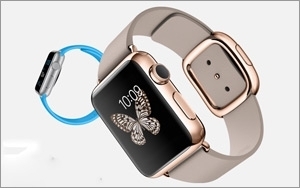Commentary
Search Targeting Turns Physiological In 2015 With Help From Wearables
- by Laurie Sullivan , Staff Writer @lauriesullivan, January 2, 2015
 Wearable devices will keep more smartphones in pockets and purses this year, but the physiological makeup of consumers will play more of a role when it comes to targeting campaigns and
advertisements. The mobile device will help targeting become more personal. We see it in numbers from Internet giants such as Amazon, from which nearly 60% of its customers shopped using a mobile
device this holiday season, compared with 50% in 2013.
Wearable devices will keep more smartphones in pockets and purses this year, but the physiological makeup of consumers will play more of a role when it comes to targeting campaigns and
advertisements. The mobile device will help targeting become more personal. We see it in numbers from Internet giants such as Amazon, from which nearly 60% of its customers shopped using a mobile
device this holiday season, compared with 50% in 2013.
About a fifth -- 18% -- of U.S. adults say they will probably or definitely purchase wearable technology in the next 12 months, per Ipsos MediaCT. Most consumers will use wearable devices to track activities, tell time and basic apps, per BIA/Kelsey, citing data from GFK. Wearable technology creates a "Connected Me" world that fuels a continuous data stream, per BIA/Kelsey. Analyst Rick Ducey believes the "connect me" data combined with other data puts targeting in hyper-drive and brings the industry close to closed-loop marketing.
Location signals and time stamps from GPS, Bluetooth beacons, and cell towers will establish current context and historical time and space movement pattern, per Ducey. More physically active consumers will be targeted differently than those who are less physically active. The signals to target campaigns will require a "where am I and what do I want next" approach.
Implications for national brands in what Ducey calls a "Connected Me" world of local search gives brands access to biometric intent signals based on context like physiological search, moods, body temperature, and heart rates, per Ducey, who said at the MediaPost Search Insider Summit last month that the industry will see an increased surge of content marketing and new types of native advertising. Context-driven search will target messages like "Try a decaf cappuccino at Starbucks" when the person's heart rate rises.
Ducey said Connected Me signals, machine learning, predictive algorithms, and rules-based scenarios will take local search to new levels.
It will take time for these messages to arrive, but they will. Mobile commerce accounted for more than 20% of total online spend Thanksgiving Day, Black Friday and Cyber Monday, per comScore.
At Amazon, Cyber Monday was the peak mobile shopping day, although Black Friday had the most rapid growth in mobile. While Amazon doesn't share information about popular search words, Shmuli Goldberg, marketing director at Feedvisor -- an algorithmic repricing platform that manages more than $1 billion in inventory for Amazon sellers -- ran down a list of some popular holiday items for 2014.
On Cyber Monday, 18 toys per second were ordered by Amazon customers from a mobile device. Holiday bestsellers include the movies Guardians of the Galaxy, and Maleficent; the toys, Disney Frozen Sparkle Princess Elsa Doll, Anki Drive Starter Kit Smart Robot Car Racing Game, and Bounce-Off Game; and the video games Call of Duty, Advanced Warfare, Just Dance 2015, and Super Smash Bros.



